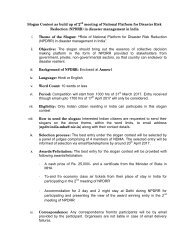National Disaster Management Guidelines School Safety Policy
School-Safety-Policy
School-Safety-Policy
You also want an ePaper? Increase the reach of your titles
YUMPU automatically turns print PDFs into web optimized ePapers that Google loves.
SCHOOL <strong>Safety</strong><br />
POLICY <strong>Guidelines</strong><br />
six months and the deficiencies may be assessed for updation of the plan. This section of the plan<br />
should clearly indicate the steps to be followed to conduct the mockdrills and the responsibilities of<br />
the teachers, non teaching staff and students. If required school should invite the Fire Service Officers<br />
and trained Civil Defence volunteers for support. The steps to be followed for earthquake drill are<br />
mentioned below.<br />
Annexure<br />
Earthquake drill:<br />
i. Practice drop, cover and hold.<br />
ii. Evacuate classroom in less than 1 minute without pushing and falling.<br />
iii. Evacuate school in less than 4 minutes.<br />
iv. Lookout for friends.<br />
v. Stay away from weak areas/ structures.<br />
vi. Help those who need assistance (identification of task force in advance for rescue of special<br />
children).<br />
Fire/ Chemical Accident/ Drill:<br />
i. Evacuation from classroom<br />
ii. Ensure safe storage of inflammable liquids/ chemicals<br />
iii. Put off electricity and remove or close down gas connections.<br />
i. Capacity building and training:<br />
Capacity Building and training of students and teachers is an important step to ensure safety of<br />
school going community in a disaster situation. Every year appropriate number of teachers and<br />
students may be trained in various skills of disaster management.<br />
Action plan for training of teachers, non teaching staff and students on DM including all the task<br />
forces constituted and also organising refresher courses. This can also include documentation of<br />
details of trained teachers and students.<br />
j. Awareness generation and sensitization:<br />
Awareness generation/ sensitization is a part of preparedness measures aiming at sensitising<br />
and educating all the stakeholders including students, teachers and officials/ parents on issues<br />
relating to school safety. It is suggested that an annual calendar of events may be prepared<br />
including various activities involving students/ teachers, etc. where experts from outside may<br />
also be invited for giving their opinion on school safety issues.<br />
Some of the measures which could be undertaken by the school management for creating<br />
awareness are as follows:<br />
a. Through poster, audio-visual clips, organizing debate, quiz, sports activities, drawing<br />
competition, rally in schools.<br />
b. Display of important information on school notice board including school evacuation plan<br />
and weather news information.<br />
c. Conducting seminars and lectures on making the learning environment safer and<br />
involvement of Parents in such seminars.<br />
d. Observing a month of safety in the year calendar of school as Preparedness month.<br />
Section 4 : Response:<br />
a. Hazards specific response plan including Crowd <strong>Management</strong> to avoid stampede on special days<br />
like annual functions, sports day etc.<br />
48



